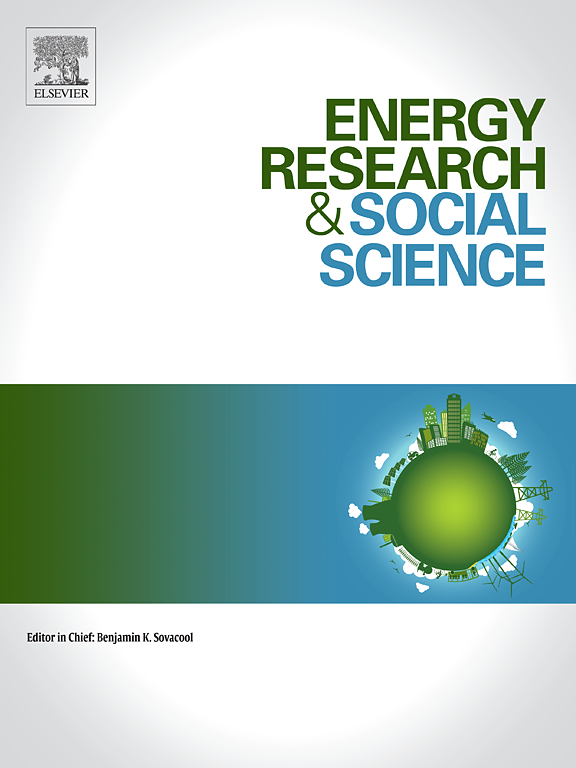Hydrogen innovation and just transitions: Exploring sociotechnical configurations of energy futures in a post-industrial community
IF 6.9
2区 经济学
Q1 ENVIRONMENTAL STUDIES
引用次数: 0
Abstract
Hydrogen innovation is gaining political momentum to meet climate change and energy security goals. In the UK, hydrogen innovation is centred within industrial hubs including Teesside in Northeast England. This study, based on interviews with industry, policy, and public stakeholders (n = 14), community workshop participants (n = 16), and regional survey respondents (n = 1021) across Teesside, explores the place-based sociotechnical configurations of hydrogen governance emerging within a post-industrial community. We find that although urgency and global competition dominate policy and industry sociotechnical configurations of hydrogen innovation, at the local scale, hydrogen is valued for its potential to diversify and reinforce the fragile regional economy; one historically dependent upon petrochemical and steel industries. While hydrogen innovation is recognised for its positive economic impact, community stakeholders express concern over weak regulatory governance and the financial risks associated with early hydrogen adoption. Distrust in hydrogen industries and regulatory authorities arises due to what we term a “contagion effect” stemming from perceived poor governance across other energy and water utilities. Sociotechnical configurations related to just hydrogen transitions are tied to regional identity, with the post-industrial Northeast perceived either as a place of exploitation or as a beacon of hope for future economic renewal. Teesside is often marked by identities tied to deprivation and industrial stigma. A just hydrogen transition therefore necessitates not only recognition of local worker needs and trust-building with industrial authorities but also stronger acknowledgement of regional post-industrial and re-industrialising identities, alongside effective public representation in hydrogen decision-making.
氢创新和转型:探索后工业社会能源未来的社会技术配置
氢创新正在获得政治动力,以满足气候变化和能源安全目标。在英国,氢创新集中在工业中心,包括英格兰东北部的提赛德。本研究基于对Teesside的行业、政策和公共利益相关者(n = 14)、社区研讨会参与者(n = 16)和区域调查受访者(n = 1021)的访谈,探讨了后工业社区中出现的基于地点的氢治理社会技术配置。我们发现,尽管紧迫性和全球竞争主导了氢创新的政策和行业社会技术配置,但在地方层面,氢的价值在于其多样化和加强脆弱区域经济的潜力;一个历史上依赖于石化和钢铁工业的国家。虽然氢创新因其积极的经济影响而得到认可,但社区利益相关者对监管不力和早期采用氢相关的金融风险表示担忧。对氢工业和监管机构的不信任源于我们所说的“传染效应”,这种效应源于人们对其他能源和水务公司治理不善的看法。与氢转换相关的社会技术配置与地区身份有关,后工业时代的东北要么被视为剥削之地,要么被视为未来经济复兴的希望灯塔。蒂赛德常常被贴上与贫困和工业耻辱相关的身份的标签。因此,公正的氢能转型不仅需要承认当地工人的需求和与工业当局建立信任,还需要更强烈地承认地区后工业和再工业化的身份,以及在氢能决策中有效的公众代表。
本文章由计算机程序翻译,如有差异,请以英文原文为准。
求助全文
约1分钟内获得全文
求助全文
来源期刊

Energy Research & Social Science
ENVIRONMENTAL STUDIES-
CiteScore
14.00
自引率
16.40%
发文量
441
审稿时长
55 days
期刊介绍:
Energy Research & Social Science (ERSS) is a peer-reviewed international journal that publishes original research and review articles examining the relationship between energy systems and society. ERSS covers a range of topics revolving around the intersection of energy technologies, fuels, and resources on one side and social processes and influences - including communities of energy users, people affected by energy production, social institutions, customs, traditions, behaviors, and policies - on the other. Put another way, ERSS investigates the social system surrounding energy technology and hardware. ERSS is relevant for energy practitioners, researchers interested in the social aspects of energy production or use, and policymakers.
Energy Research & Social Science (ERSS) provides an interdisciplinary forum to discuss how social and technical issues related to energy production and consumption interact. Energy production, distribution, and consumption all have both technical and human components, and the latter involves the human causes and consequences of energy-related activities and processes as well as social structures that shape how people interact with energy systems. Energy analysis, therefore, needs to look beyond the dimensions of technology and economics to include these social and human elements.
 求助内容:
求助内容: 应助结果提醒方式:
应助结果提醒方式:


